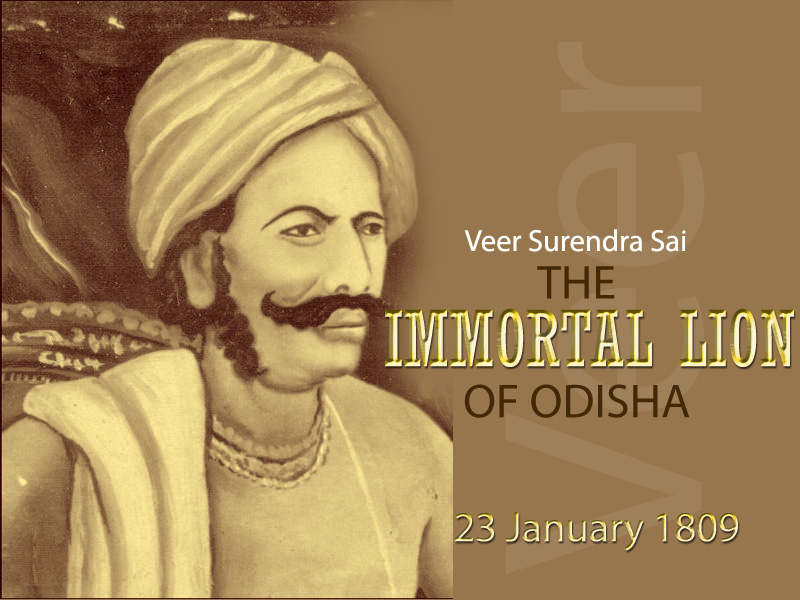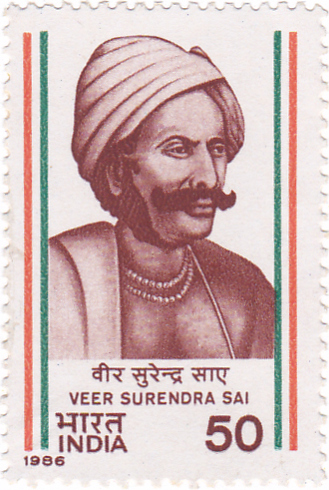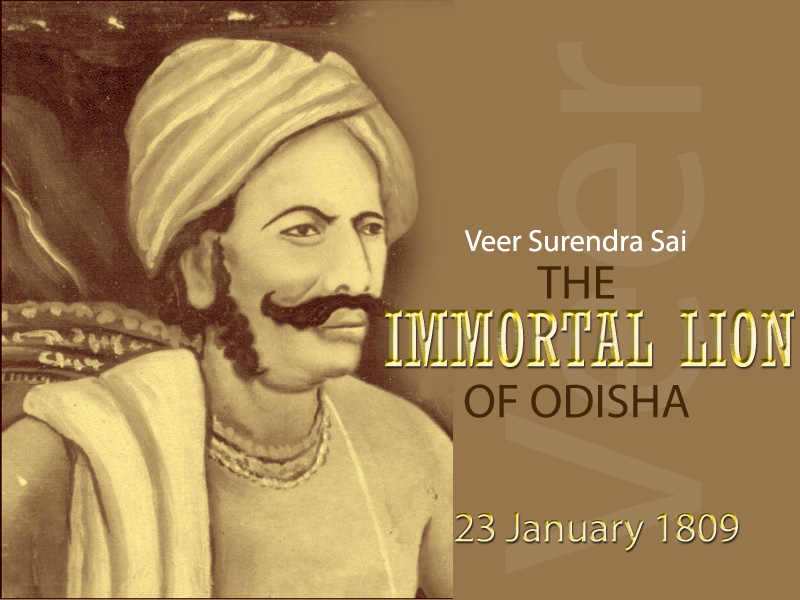During the rule of the British Empire in India, there were many rebellions in what would become the state of Odisha. One of the greatest revolts of this period was in Sambalpur by the freedom fighter Surendra Sai and his companions. So great was his valour that the common people conferred the title of Beera (Veer) to him. Thus he has come to be known as Veer Surendra Sai.
Brave warriors like Madho Singh, Kunjal Singh, Airi Singh, Bairi Sing, Uddant Sai, Ujjal Sai, Khageswar Dao, Salegram Bariha, Govind Singh, Pahar Singh, Rajee Ghasia, Kamal Singh, Hati Singh, Salik Ram Bariha, Loknath Panda/Gadtia, Mrutunjaya Panigrahi, Jagabandu Hota, Padmanave Guru, Trilochan Panigrahi and many more gathered under Veer Surendra Sai’s banner and resisted British rule in Sambalpur for far longer than any other freedom fighters.
Beginnings
Surendra Sai was born on 23rd January 1809 into the Chauhan clan of Khinda-Rajput in the village of Khinda about 21km from Sambalpur. His father Dharam Singh was a descendant of Madhukar Sai, the fourth Chauhan ruler of Sambalpur. This meant that he had a legitimate claim to the throne of Sambalpur, albeit a few places below the direct descendants of the current ruler.
Dharam Singh sired six more sons, but did not live to see them grow up. His younger brother Balram Singh was the one who raised the seven siblings in his place. As a boy Surendra was very interested in martial pursuits like swordfighting and horse riding but was less inclined to the scholarly arts. This tendency of his was noted by the people around him who predicted that he would be a great warrior.
The Claim
In 1827, Maharaja Sai, the ruler of Sambalpur died without issue. This led to a scramble for the throne, of which Surendra was also a claimant. However, the British had already occupied Sambalpur back in 1804 when they won against the Marathas in the 3rd Anglo-Maratha war. They appointed Maharaja Sai’s widow Mohan Kumari as the ruler. However, she had no knowledge of rulership and Sambalpur suffered under her reign.
You can read our another post on Bali Yatra: The Celebration of Maritime Splendor

Mohan Kumari’s reign had angered the other claimants of the throne and her inept rule had made the people miserable. So, the people revolted against her in 1828. Leadership of the rebellion was taken by Surendra Sai. This forced the British to put the rebellion down and depose Mohan Kumari in 1833. She was sent to Cuttack and lived the rest of her life as a pensioner.
This time again the British ignored Surendra Sai’s claim and gave the throne to Narayan Singh, a descendant of the ruling clan but of a lower caste. This time, Surendra was not going to take it lying down, so he once again rose in revolt. He was supported by his brothers Uddhant, Dhrub, Uijjval, Chhabil, Jajel and Medini. Alongwith him were the Gond tribe and the zamindars around Sambalpur who were dissatisfied by British control over the throne.
The skirmishes between the rebels and the British forces were fierce but Surendra Sai’s forces always came out the victor. However in 1840, the British managed to capture Surendra Sai, his brothers Uddhant and Ujjal, and his uncle Balram Singh. Narendra Singh petitioned the British for death penalty for the rebels but the British decided on life imprisonment. The four of them were imprisoned in Hazaribagh jail where they remained for 17 years.
Meanwhile Narayan Singh died childless in 1849. Following the ‘Doctrine of Lapse’ Lord Dalhousie ordered the annexation of Sambalpur to the Empire. This intensified the resistance even though the leaders were in jail.
The 1857 War for Independence and the Aftermath
In 1857, the sepoys of the British army rebelled and started the struggle for independence. The kings of Odisha did not join. However, the mutiny spread to Hazaribagh jail and the prisoners broke out. Among them were Surendra Sai and his brothers Uddhant and Ujjal. Sadly, Balram Singh had died in prison.
Surendra Sai and his posse of rebels reached Sambalpur shortly. Meanwhile the war was winding down as the British defeated the rebel forces. In 1858, the British officially declared the war over, but Surendra Sai’s war was far from over. Sambalpur remained in rebellion.
Initially, Mr. Ley tried to negotiate a peace between the two forces with exile for Surendra Sai. The terms were rejected and in retaliation the British burnt down the ancestral home of Surendra Sai in Khinda. Sometimes later, Chhabil Sai was killed resisting British attack. This ignited the whole region into revolt.

Surendra and his brothers organized the rebel forces as guerilla units, attacking British forces and then fading out into the hills surrounding Sambalpur. So fierce was the resistance that the British sent the ruthless Major Forster to suppress it. He had previously been successful in crushing the Independence Army in many places in India. Alongwith him came a veteran army bloodied by the war.
However to his dismay, Major Forster was unable to suppress Surendra Sai’s forces. The unconventional tactics and superior knowledge of the terrain of the rebels allowed them to strike British targets with impunity. This forced the Empire officials to recall Major Forster in disgrace in 1861. In his place came Major Impey.
He could see the writing on the wall. The rebellion was getting too costly and no amount of atrocities were capable of stopping it. He followed the policy of reconciliation and ask the rebels except Surendra Sai, his son Mitrabhanu and Uddhant to surrender in exchange for amnesty in late 1861. A month later he made another proclamation issuing a blanket pardon to all who surrender.
The rebellion had drawn long, with morale flagging and supplies getting low. Mitrabhanu and Uddhant Sai decided to surrender to Major Impey in 1862. He sent both of them back to Surendra Sai to negotiate his surrender. Seeing the condition of his forces, which were tired from battle, Veer Surendra Sai surrendered to Major Impey on May 16th, 1862.
All rebel forces were given full pardon for their acts against the British during the Sambalpur Rebellion. Major Impey honoured the truce and peace once again reigned in Sambalpur.
This peace was not to last, as Major Impey died in 1869 and Major Cumberland was appointed to his post. People in the colonial administration were still not happy with Major Impey’s decision to let Surendra Sai go. So they implored Major Cumberland to ignore the previous Deputy Commissioner’s decision and arrest Surendra Sai. In 1864, British forces captured Surendra Sai and his cohorts.
The Sentencing
Surendra Sai and several others were sentenced to life imprisonment at the Asirgarh Fort far away from Sambalpur. Many of them were transported for life to the Cellular Jail in Andaman. In 1876, Dhruva Sai and Mitrabhanu Sai were released from prison under the surety of the King of Bonai. Surendra Sai remained imprisoned in Asirgarh for the rest of his life. On 28th February 1884, Veer Surendra Sai breathed his last, now far away from the motherland for which he shed blood and tears.
Conclusion
This rebellion had long lasting effect on the rule of the British Empire in India. Local zamindars no longer had the freedoms they used to enjoy before. The British put many restrictions on the power of the zamindars and abolished the system of ‘bethi’ and ‘begari’ that was present before. An effective land revenue system was put in place in Sambalpur.
The tyranny and treachery of the British showed their two faced nature and exposed them as the power hungry fiends they were. This would inspire other people to take up the torch of resistance and oppose the British. However, the throne of Sambalpur was abolished completely and no one agitated for its restoration ever again.
Veer Surendra Sai’s rebellion against the British rule may not have succeeded but he still managed to bloody their noses. He resisted against tyranny his whole life. All the forces of the British together failed to suppress his rebellion and he only surrendered because he saw the opposing commander was spent and got a favourable outcome. He was only captured when the British got back on their word and used treachery against him and his people.
Veer Surendra Sai Statue, Jail Chowk, Sambalpur, courtesy https://familypedia.wikia.org/wiki/Sambalpur
Veer Surendra Sai’s name languished in darkness for decades but recently, there has been efforts by the Odisha Government to bring it back into prominence.
- Jharsuguda Airport has been renamed Veer Surendra Sai Airport.
- University College in Burla, Sambalpur, the oldest engineering college of Odisha changed its name to Veer Surendra Sai University of Technology in his honour.
- Burla Medical College was also renamed to Veer Surendra Sai Medical College.
- A postage stamp was released in his honour
- Veer Surendra Sai Stadium in Sambalpur is named after him.
- VSS (Veer Surendra Sai) Market Complex in Chhend Colony, Rourkela is also named after him.
Sources
- Odisha Review, August 2012: Surendra Sai: The Great Freedom Fighter
- Ei Matir Itihas: Bira Surendra Sai by Radio Choklate 104 FM https://youtu.be/5Ys2jNodrTc

